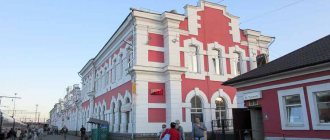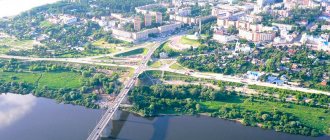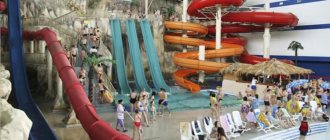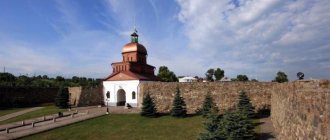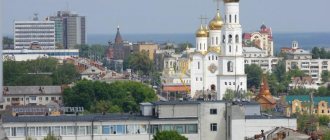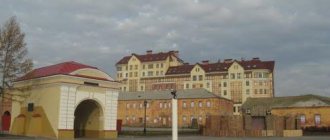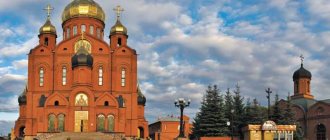The Tyumen region, figuratively called the “Gateway of Siberia,” together with two autonomous okrugs (Yamalo-Nenets and Khanty-Mansiysk), stretches from the Arctic Ocean to the Russian border with Kazakhstan and is the largest oil and gas producing region in the country. In addition to mineral resources, it has the largest water reserves - rivers, lakes and thermal springs, as well as the third largest forest resources in the country. The magnificent nature and sights of the Tyumen region are very suitable for starting to explore Siberia.
Tyumen
Founded by decree of Tsar Fyodor Ioannovich in 1586 on an old settlement that belonged to the Tyumen Khanate. The wooden fortress of the first Russian city in Siberia was founded by the Cossacks on the high bank of the Tura for the defense of the eastern borders of the state and as an outpost for the development of Siberia.
Scientific, industrial and cultural center of the region. The combination of historical monuments and urbanism gives the city a special atmosphere. The population of Tyumen is about 700 thousand people, most of whom are under 35 years old. A magnificent view of the modern city opens from the cable-stayed pedestrian bridge of lovers across the Tura, which has a 4-level embankment.
Walking through the city center, its residents and guests enjoy visiting the world’s only Square of Siberian cats, which were taken to besieged Leningrad to get rid of rats, with 12 cast-iron and gold-painted sculptures of charming furry animals in different characteristic poses on pedestals.
You can get acquainted with the sights of the Tyumen region by visiting its museums and architectural monuments, many of them are of federal significance. This is the oldest monastery in Siberia, the Holy Trinity Monastery in Tyumen, founded in 1616 by the monk Nifont who came from Kazan. Peter I granted 1 thousand rubles for the construction of a shrine in the Russian and Siberian style.
The natural attractions of the Tyumen region are represented by numerous hot thermal springs, varying in their unique composition and temperature. The most popular ones are located 11 km from the regional capital in the town of Verkhniy Bor. There is a legend that the conqueror of Siberian lands, Ataman Ermak, and his army gained strength and health here. A well for the release of healing mineral waters was drilled to a depth of 1233 m in 1985. At any time of the year, the temperature of the source does not fall below +40°, and around it there is a popular recreation center with two swimming pools.
One of the attractions of the Tyumen region is the wonderful lake Big Taraskul (translated from Tatar as “lake of horseflies”), 14 km from the city of Tyumen, with an area of 1.5 square meters. km. Part of the coast is sandy and dry, and part is swampy. The lake is filled with sapropel - centuries-old bottom reserves of therapeutic mud of high biological activity and is a natural monument of local importance. It is no coincidence that a large balneological health resort of federal significance with 850 beds is located here.
Architectural and park complex “Good Angel of Peace”
The sculpture in the center of this complex is considered a symbol of Nizhnevartovsk. The grand opening took place during the celebration of the national holiday - Russia Day, in 2013 in the presence of the head of the city. In the same year, the complex was consecrated, and new benches were installed nearby. The author of the composition was the artist P.T. Stronsky.
Location: Zakharova street
Tobolsk
Tobolsk, a monument city far from the highways, was founded in 1587 and became a Siberian trading post on the way from the center of the country to Central Asia and China. From here education, science, Orthodoxy, crafts and stone construction spread to Siberia. Lost its status as a provincial town in the 1820s. due to the distance from trade routes and the railway. Nowadays it is a unique center of educational tourism.
A monument of federal significance, the only one in the Trans-Ural region, the Tobolsk Kremlin is what every traveler needs to see in the Tyumen region. It was built of stone 100 years from 1700 on the site of wooden predecessors on the high 60-meter Trinity Cape with a magnificent view of the river. Irtysh. An ancient paved road leads from the foothills to the Kremlin - Sofia Vzvoz - fortified with high brick walls.
The modern Kremlin includes:
- Saint Sophia Cathedral;
- 2 bell towers;
- Church of the Intercession;
- bishop's house;
- monastic corps;
- guest courtyard;
- consistory;
- rentery;
- belfry;
- walls with towers;
- prison castle.
Next to the Kremlin you can see the Church of the Holy Trinity in the neo-Gothic style, built for exiled Poles and Lithuanians in 1907. The Tobolsk region gave Russia many outstanding people: the chemist D. I. Mendeleev, the poet-storyteller P. P. Ershov, the composer A. A Alyabyev, artist V. G. Perov. Since the 1830s In the settlement in Tobolsk there were exiled Decembrists, many of whom did not have a chance to see their native places.
Cathedral of the Resurrection of Christ
Construction of the Orthodox church with five domes was completed in 2005, and a few months later it was consecrated.
Near the cathedral there is the “Orthodox Park”, a monument to the Slavic enlighteners - Cyril and Methodius, and the temple of St. Prince Vladimir. There is a Sunday parish school on the territory of the complex. The Church of the Resurrection of Christ was mentioned in the novel “View from the Window” by S. Kozlov.
Location: Khanty-Mansiysk, st. Gagarina 9.
Ishim
The history of the country begins with the history of provincial cities. The district center of Ishim became such a city, which grew out of Korkina Sloboda, in 1721 at the behest of Peter I. The holding of the annual all-Russian St. Nicholas Fair, the construction of stone and wooden churches, numerous merchant houses and estates made this city a district town. More than 40 architectural monuments have survived to this day. The cultural center of the city is the Ishim Museum of History and Local Lore, which has collected a rich collection of fine art and archaeological finds, evidence of merchant life, political events of the region, including the anti-Bolshevik uprising of 1921. The museum is located in a 19th-century building, built at the expense of the local merchant and philanthropist N. M. Chernyakovsky.
Yalutorovsky Museum Complex
The complex includes: the Museum of Local Lore, the House of the Decembrist M.I. Muravyov-Apostol, Museum “House of Nature”, open-air exhibition “Ecological Yard”, House of the Decembrist I.D. Yakushkin.
Several large natural science, clothing, documentary, and numismatic collections are collected here. Weapons from different centuries are kept. The pride of the complex is a rare book, which contains historical manuscripts, fragments of publications of the 18th and 19th centuries.
Location: G. Yalutorovsk, st. Revolutions, 75.
Abalak
The village is located 25 km from Tobolsk on the banks of the Irtysh and was Tatar before the annexation of Siberia to Russia. The site of the decisive battles between the troops of the Cossack ataman Ermak and the Tatar prince Mametkul. Here are located male and female monasteries, famous for their miraculous icons. A popular place in the Tyumen region for tourists of all ages, it attracts with its historical complex with wooden buildings in the ancient Russian style: a fortress, chambers, a tavern, near which fascinating reconstructions of the “Abalak Field” battles are held every year.
Monument to Semyon Remezov
The sculpture has been on the city's Red Square since 2005. It was installed by a man who made a huge contribution to the creation of the architecture of Tobolsk. Semyon Ulyanovich was the author of the project during the construction of the Tobolsk Kremlin. During his lifetime he was a cartographer and chronicler. In his drawings he described in detail the entire history of Ermak’s campaigns. The creator of the monument is sculptor O. Komov.
Location: Tobolsk, Red Square - 4
Museum of Grigory Rasputin
A very popular and unusual museum was created by the Smirnovs in the village of Pokrovskoye, 80 km from Tyumen in the homeland of the “great old man” and became the first private museum in the Soviet Union. Unique exhibits are associated with the legendary personality of Rasputin, who was killed in 1916 by his family, and create a unique mystical atmosphere. One of the rarities - an authentic Viennese chair of an old man - according to popular legend, has healing properties. The tours are conducted by the owners of the museum themselves and leave no one indifferent.
Monument to the conquerors of Samotlor
It was opened in 1978. The second name of the 12-meter monument is “ Alyosha ,” but it has nothing in common with the Murmansk monument of the same name. This monument was not built in honor of the memory of the exploits of people during the Great Patriotic War. And it reminds of the exploits of those who developed the oil lake Samotlor in the 60s of the last century. Large quantities of “black gold” have been mined from it for almost 50 years.
The explorers of Samotlor are geologist, builders and assemblers. The sculpture depicts a man holding a torch with an eternal flame burning in his hands. The authors were architects Y. Kozhina and I. Vasilenko, sculptor I. Kostyukhin. During the Soviet period, a capsule with a written message from the city residents to their descendants in 2021 was laid at the foot of the monument.
mound of Glory
Maryino Gorge
Located in the Isetsky district in the south of the region on 27 thousand hectares of the ancient terrace of the river. Iset with unique Red Book fauna and flora, the remains of ancient burial grounds and ancient settlements. Due to numerous folk legends, the place has become sacred and is associated with the death of participants in the Civil War here. The ravine is perfect for playing geocaching, and against the backdrop of the river floodplain, hikers usually take wonderful photos of the sights of the Tyumen region. There are tourists with tents here, at the bottom of the gorge there is a clear spring, and in the village of Isetskoye you can visit the folk museum of local lore.
Tobolsk Kremlin
Construction of the Kremlin lasted from 1683 to 1799. Today it is the only surviving stone Kremlin in the entire region. It is a monument to Siberian architecture. Within its walls, the St. Sophia-Assumption Cathedral, the Intercession Cathedral, the building of the judicial administration, the Fortress Pavlinskaya, the South-Eastern Angular and Orlovskaya towers are open to the public.
Red Square - 1с4
Nigmatulla Hadji Mosque in Embayevo
When planning excursions in the Tyumen region, one cannot help but visit the village of Embaevo, 18 km from Tyumen, representing Muslim Siberia and founded by Bukhara merchants who came to trade fabrics, leather goods, dried fruits and spices. In 1884, merchant and philanthropist Nigmatulla Karmyshakov-Saidukov financed the construction of a mosque and religious school according to the design of a Lutheran from Prussia, Gottlieb Zinke. The Islamic complex also includes a hotel, library, kitchen and dining room.
After a devastating fire in the village, the philanthropist built 176 houses for local residents. Nigmatulla Khadzhi Karmyshakov-Saidukov was buried in the village cemetery in 1901. The austere and elegant architectural form of the mosque demonstrates the successful combination of the principles of construction of Muslim and Orthodox religious buildings.
Reviews from tourists
The embankment and lovers' bridge in Tyumen are magnificent. In the evening everything is illuminated and a festive mood is created. In general, the city has parks where you can relax, walk with your children and go on rides.
Tourists enjoy visiting the original Rasputin Museum, where they can learn a lot of interesting things about this man. According to their reviews, the collection of photographs of the elder and books about him is especially striking. The museum is very popular not only among ordinary visitors, but also among celebrities.
The various cultural and natural attractions of the Tyumen region in the photo with descriptions of excursion routes will help plan leisure time for both lovers of educational travel and supporters of eco-tourism, hunting and fishing.
What travel can teach you
Why do people travel? Is it really just to take a 2-week break from work, spend the money accumulated over six months and create the illusion that “they can afford it”?
You look up from the couch.
Thinking about the upcoming voyage, we begin to worry about the difficulties that await tourists. We are worried that we will not find a place to stay for the night, that we will not be able to communicate with the residents of another country in our broken English. What do travel teach? Because all the fears listed above are in vain. Gather your courage, put aside your worries, focus on your goal and hit the road. It is a mistake to think that traveling is either a “round the world” trip, where you burn all your bridges, or a package holiday, which limits you to an all-inclusive system. How much do you know about the surrounding areas of your city? About the life of residents of neighboring villages? Surely there are a lot of interesting things near you. Start discovering the world small.
Travel changes your worldview
The first thing he learns after visiting different countries is that exotic places are not as dangerous as they seem. You can feel comfortable in any city. This rule also applies to wildlife: by following basic safety rules, you are guaranteed to avoid trouble. Moreover, in a metropolis a person is more likely to die (for example, by being hit by a car) than in a desert or forest.
You will constantly expand your horizons
What are travels for? To get to know the world and get acquainted with the culture of other peoples. Don't worry about the friendliness of the people: the locals always treat travelers politely and try to help them. If you are not a Tagil fan, don’t spoil their heritage and don’t laugh at the culture of the country in which you are a guest, then traveling will definitely bring you new acquaintances and faith in people. Many people will be happy to provide you with an overnight stay, show you the way, and tell you about the interesting sights of their country.
You don't have to be a millionaire to see the world
Travel more and you will realize that you don't need to spend millions to do it. Big money is necessary only for those who dream of a sea cruise to exotic islands. Although, if you make friends with the locals, you can easily avoid these expenses. When organizing your travels yourself, you only need to have a small amount of cash to buy food, pay for transport and hotel rooms or places in hostels. Living in the latter, by the way, despite its cheapness, can give you a huge amount of experience and impressions.
Things are just things
First-time tourists consider it their duty to take 10 suitcases on the road with outfits for all occasions and full equipment in case of the end of the world. But over time, travel teaches that an abundance of luggage only gets in the way. A person on the road (as in life) needs a minimum of clothing, two pairs of shoes, hygiene products, money and documents. Once you start traveling, you will realize that you absolutely do not need most of the things you have, and you can painlessly get rid of them by freeing up space in your closet. The same applies to unnecessary emotions, unnecessary worries, uninteresting people and habitual obligations - by getting rid of such “junk”, you will make room for new things.
Find out the difference between a tourist and a traveler
Travelers and tourists are not the same thing. The first ones communicate with local residents, get acquainted with traditions, make new acquaintances, change their worldview and improve their lives. The latter fearfully glance at everything that is happening from the windows of the bus. Locals scam tourists out of money, and share food and shelter with travelers. Travel changes people and teaches them that they need to be simpler and not be afraid to learn new things, teach them to be open with others and appreciate every person who comes into life.
By leaving your usual environment, even for a short period of time, turn your life into a journey full of uncertainty, and you will be able to get to know yourself from the most unexpected sides.
Travel is not a vacation
You've probably heard more than once how traveling changes many people, making them stronger and more resilient. And you actively travel to Cyprus and Turkey, but you don’t notice any changes... And this is not because hiking in the mountains or tundra with a heavy backpack is a workout for the body. Not because in the most harmless resort city you can be left without money or find yourself in a difficult situation. It’s just that when you travel, you don’t set the goal of “lying down” under a palm tree, relieving stress from work or family. You change your lifestyle from the usual to an improved version of it. Traveling can be physically difficult, but it also relieves the mind. Therefore, they are not looking for physical relief; they provide much more than relaxed muscles.
You are your best friend and travel companion
Can't find travel companions to go on the road with a fun group? This will only benefit you. There is no better way to understand yourself, the world, determine life goals and cultivate fortitude than solo travel. Traveling alone is an incomparable experience. By relying only on your own strengths, you will begin to believe in yourself more and learn to make responsible decisions on your own. This will make it easier for you to meet new people, try unusual things and take on unfamiliar roles, since you won’t have to look up to anyone and won’t be afraid of anyone’s judgement.
It's a small world
Long journeys have changed the opinion of millions of people that our planet is vast. It only seems like this when you watch about other countries on TV. In reality, it is possible that you will meet your friends when you go to Cambodia, India or Kamchatka. Or, in a quiet, remote corner of the world, meet someone from your hometown. Travel more and don’t be afraid to communicate with people and look for new acquaintances. Perhaps one of the billions of people who will change your life will meet you in a place you never thought possible.
